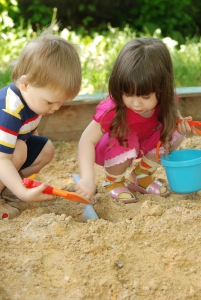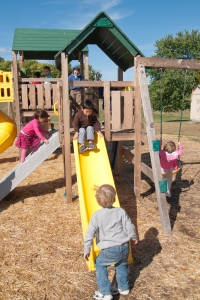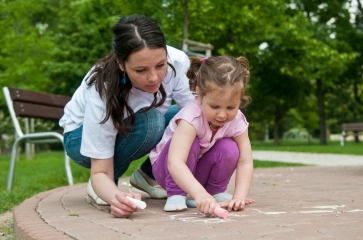 When you recall your childhood, do some of your fondest memories revolve around unstructured outdoor play? Did you make dandelion soup and mud pies, create sand castles, and run through sprinklers? Was your favorite grade school subject “recess?”
When you recall your childhood, do some of your fondest memories revolve around unstructured outdoor play? Did you make dandelion soup and mud pies, create sand castles, and run through sprinklers? Was your favorite grade school subject “recess?”
Although it is still just as exciting, young children today are spending less and less time outdoors. There are many possible explanations for why this is happening. Here are just a few:
- Television, computer, and video game use.
- Parents may fear for the safety of their child outdoors (traffic, disease-carrying insects, harmful sun rays, kidnapping, etc.).
- Increased urbanization has resulted in fewer areas for children to play (more concrete and parking lots and less grass and parks).
The trend of less outdoor time for children is not a positive one. Decreased time outside can mean less physical activity, which can lead to childhood obesity, or at the very least, the development of unhealthy habits.
Children should be given the opportunity to spend time outdoors every day, even throughout the winter months. Be sure that the area is safe for children. Playground equipment should be well maintained and appropriate for your child’s age and development. Drinking water needs to be available,  as well as areas with shade. Young children should always be supervised by an adult.
as well as areas with shade. Young children should always be supervised by an adult.
Unstructured outdoor play serves many important developmental functions. It allows children to be active as they learn, which is often much more effective. Children enjoy more freedom to run, jump, skip, yell, and be messy! Such behaviors are not practical when indoors, but are very important. They allow children to relieve stress and use up excess energy.
Children learn about the environment and the world around them when they play outside. This triggers the development of scientific thinking. Gardening and sandbox play are wonderful outdoor activities that can teach children about cause and effect, spatial awareness, measuring, making comparisons, counting, and more.
The outdoors easily lends itself to imaginative play. Baking mud pies, flying like butterflies, and washing riding toys are all examples of imaginative play that children can create and enjoy outdoors.
Children learn much more when they are able to use their senses. Outdoors, they are able to fully experience the weather and the seasons. When they watch a rain shower on television, they can see and hear it. If they were to experience a real rain shower outdoors, they would be able to see, hear, feel, taste, and smell it!
 Since all of these things cannot be recreated any other way, spend time with your child outdoors as often as possible. Read a book under the shade of a tree, walk through a park, write on the sidewalk with chalk, wash your car, or enjoy a picnic lunch in the backyard with your child today!
Since all of these things cannot be recreated any other way, spend time with your child outdoors as often as possible. Read a book under the shade of a tree, walk through a park, write on the sidewalk with chalk, wash your car, or enjoy a picnic lunch in the backyard with your child today!
Back to blog listing